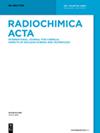基于羧甲基纤维素的无机复合材料:制备、表征、对放射性溶液中某些放射性核素的吸附和选择性行为
IF 1.7
3区 化学
Q4 CHEMISTRY, INORGANIC & NUCLEAR
引用次数: 0
摘要
本研究对放射性溶液中131Ba、109Cd、152+154Eu和97Zr的吸附和分离进行了研究,并将其吸附到负载于羧甲基纤维素(BaMoTi@CMC)复合材料上。本文采用共沉淀法制备了不同的BaMoTi@CMC复合材料样品,并使用不同的分析工具,如x射线衍射(XRD)、衰减全反射(ATR)和扫描电子显微镜(SEM)对其进行了表征。对131Ba、109Cd、152+154Eu和97Zr的批量吸附研究包括时间、pH和金属离子浓度的影响。数据表明,在所有条件下S-3的吸附效率都高于S-2。等温线由Langmuir和Freundlich模型研究。双星系统的数据证实,Cd(ii)、Ba(ii)和Zr(iv)可以用不同ph值的S-2和S-3从Cd - eu、Ba - eu和Zr - eu双星系统中分离出来。最后,数据证明Zr(iv)和Ba(ii)在pH为2的条件下可以很容易地从三级体系(Zr - Ba - cd)中分离到S-2和S-3上。本文章由计算机程序翻译,如有差异,请以英文原文为准。
Inorganic composites based on carboxymethyl cellulose: preparation, characterization, sorption, and selectivity behavior for some radionuclides from radioactive solutions
This work is interested in the sorption and separation of 131 Ba, 109 Cd, 152+154 Eu, and 97 Zr from radioactive solutions onto barium molybdenum titanate loaded on carboxy methyl cellulose (BaMoTi@CMC) composites. In this work, different samples of BaMoTi@CMC composites were fabricated by the co-precipitation method and characterized using different analytical tools such as X-ray diffraction (XRD), attenuated total reflectance (ATR), and scanning electron microscope (SEM). The batch sorption investigations on 131 Ba, 109 Cd, 152+154 Eu, and 97 Zr include the influence of time, pH, and metal ion concentrations. The data reveal that S-3 has higher sorption efficiency than S-2 under all conditions. Isotherm is studied by Langmuir and Freundlich models. Binary systems data confirm that Cd(ii ), Ba(ii ), and Zr(iv ) can be separated from Cd–Eu, Ba–Eu, and Zr–Eu binary systems using S-2 and S-3 at different pHs. Finally, the data prove that Zr(iv ) and Ba(ii ) can be easily separated from tertiary systems (Zr–Ba–Cd) onto S-2 and S-3 at pH 2.
求助全文
通过发布文献求助,成功后即可免费获取论文全文。
去求助
来源期刊

Radiochimica Acta
化学-核科学技术
CiteScore
2.90
自引率
16.70%
发文量
78
审稿时长
6 months
期刊介绍:
Radiochimica Acta publishes manuscripts encompassing chemical aspects of nuclear science and technology.
 求助内容:
求助内容: 应助结果提醒方式:
应助结果提醒方式:


